We have moved a little further south to the little coastal settlement of 'Flying Fish Point'. It is about 8 kilometres from Innisfail and could be likened to a little settlement like Drummond Cove used to be! We decided we wanted to be closer to the coast, so 'Flying Fish' it is. When we arrived about 11.30am we saw some nice fish too! The guy in the caravan next to us had been out in his dinghy and caught himself a nice bucket of mackerel. He is a retired farmer from the Rockhampton area and comes to 'Flying Fish Point' for a couple of months every year. It's not a very big park, only about 46 bays. It has been really busy, but things have dropped off in the last week. We were told the same thing later in the day at the 'Sugar Museum'. With the addition "Once it starts to warm up a bit, they all return south". We've heard this said in the north of W.A. as well! On arriving in Innisfail, we parked on the riverfront and found a cafe for our morning coffee. No photos taken of the 'Melting Moment' Peter had, which he thought would be just like the Kisses his Mum used to make.
Of course it wasn't! We enjoyed the views along the bank of the Johnstone River. We had to cross the 'Geraldton Bridge' to come out to the point and we questioned why the bridge was called 'Geraldton'! It has been Pete's research this time through google. Innisfail was known as Geraldton until 1910. The first European's arrived in 1872, but it wasn't until 1879 when an Irishman Thomas Fitzgerald arrived in the area to establish a sugar industry, that the first house was built. The area was named 'Innisfallen' after the largest island in the 'Lakes of Killarney', in Ireland. Soon after it was changed to Geraldton, being named after Thomas Fitzgerald. In 1910 it was changed again, and this time to Innisfail. This was done to avoid confusion with the town of the same name in Western Australia. Fancy that! Peter's mother and father visited Innisfail when they travelled around Australia in 1976. I remembered that they really enjoyed their stay here, so we thought we would check it out too.
Peter thinks Pat and Bernie Blackmore were living here at that time and that was the main reason they stayed a couple of weeks. We think they caught themselves some fish while here as well.The town is the major centre on the 'Cassowary Coast' and is well renowned for its sugar and banana industry. It is also one of Australia's wettest towns. Cyclone Larry brought much devastation to the region in 2006. In the towns recovery it does seem that many buildings have been freshened up with some paint. The area along the riverfront is very pleasant, but the rest of the town area doesn't look that progressive. There was some interesting reading on the web about the local Council being sacked in February 2007 by the Queensland Government. This was due to internal conflict, inappropriate behaviour and financial problems. It is also said that Innisfail is a multi-cultural town. On Tuseday afternoon we went for a drive to Mourilyan and visited the 'Sugar Museum' there. There was lots of information on establishing the sugar industry in Queensland.
'Hope' was the first European to produce granulated sugar from cane in 1862 and in 1865 he introduced island labour (known as Kanakas). It was really quite disturbing to read how these people from the islands were treated.This is from the web: "Kanaka" was a derogatory term applied to the South Sea Island
labourers shipped to Australia in the late 19th century, although some believe "Kanaka" is a Polynesian word for "man". Some were willing slaves but the majority were either brought here under false pretenses or blatantly stolen from their families to work mainly in the cane fields of
this nation. By the 1890's more than 57,000 had been brought in.Milestones for the Australian Sugar Industry are: 1962 - 1 million tonnes of raw sugar was exported for the first time. 1994 - Australia becomes leader of world sugar exports. 1995 - Largest raw sugar shipment of 61,300 tonnes from Townsville to Dubai. 1997 - More than 60% of Queenslands sugarcane crop harvested as green cane. 2012 - Australia's sugar industry is valued at $2. 5 billion. From there we went out to the 'Mourilyan Wharf'. It is not very big but it is from here that some shipments of raw sugar are exported. There was one reasonably large storage bin there. We saw videos at the Museum of how the sugar is handled.Our next stop for the afternoon was at 'Etty Point' on the coast. We had considered actually staying here, but were glad that we didn't because the road to the little coastal settlement wasn't very wide. 'Etty Point' had a nicer beach though and the brochures say the Cassowaries come onto the beach at times. None there on Tuesday afternoon, but while we were there, two Skydivers did land on the beach. Two Asian girls had paid for a skydive! The company had bussed them down from Cairns and the aircraft had taken them up from close by. Wednesday we drove 'Cane Cutter Way' and both commented on how much we had enjoyed our day leisurely driving the inland country roads. Small little towns, that appeared to us as though nothing much has changed for years. Sugarcane is being grown right up to the fences of homes and in some cases there isn't even a fence at the back of the yard. You could see the kids trampoline and swings within metres of the cane. Lots of banana plantations as well.The highlight of our days travel was the visit to 'Paronella Park'. It has such a 'Fairy Tale' story. Jose Paronella's dream was to build a castle. He came to the Innisfail area in 1913 and worked hard in the cane fields. He had left his sweetheart behind in Spain, but said "He would come back for her". He worked hard for 11 years, creating his wealth by buying, improving and selling cane farms. While travelling through the beautiful countryside he discovered virgin forest alongside the spectacular 'Mena Creek Falls' and this was a perfect location to fulfil his dream. When he returned to Spain he found his sweetheart had got sick of waiting for him and married someone else. Determined to bring a bride back to Austraila he proposed to Margarita, his sweetheart's younger sister. In 1929 with his bride, Jose returned to Australia and purchased the land, to build his dream. He built an amazing castle for his family and planted 7,000 trees. He also built a hydro electric plant in 1933 to power his park. The Paronella's invited everyone to movies on Saturday nights, built tennis courts, refreshment rooms and a ballroom. They also invited people to swim at the falls and he built change rooms for the men and women.Jose died in 1948 and his wife and children continued to manage the property until it was sold in 1977. The guide told us "Unfortunately things didn't go well for the new owners. It was around the time that the new Bruce Highway was put through. No longer did the highway go past 'Paronella Park'. In 1979 a fire swept through the Castle leaving only the walls and the turrent as a reminder of what it was. Then in 1986 cyclone 'Winifred' tested the parks endurance once again. Then the 'Fairy Tale' continued. In 1993 it was purchased by a Victorian couple who were travelling around Australia and fell in love with the property. They paid $400,000 for it and envisaged reviving Jose's dream with his appreciation for 'beauty and warm hospitality'. We certainly got that with our visit. We were greeted in the carpark. We had homemade savoury muffins for morning tea and our tour was excellent. There is also a night show that you can go to. The night show directs coloured lights onto the waterfall, gardens and remains of the castle. Your entry to 'Paronella Park' also gives you one free night in the caravan park, enabling you to come back through for the night show. Your ticket also gives you free entry for two years. I don't think we will be taking those benefits! Lunch was at 'Kurrimine Beach' and there were plenty of fishermen who had gone out from this spot. There were a couple of caravan parks and one of them was a Council Park. It looked to be very popular. Lots of little tractors were there to put the boats in the water. This was no doubt because of the lack of water on low tide. We didn't realise until doing some more web research that we could have walked out to 'King Reef' on Tuesday. For three days of the month on low tide, you can walk to the reef. The water is thigh deep for 800 metres and they do have a boat on standby in case anyone needs it. That would certainly be something different to do!
labourers shipped to Australia in the late 19th century, although some believe "Kanaka" is a Polynesian word for "man". Some were willing slaves but the majority were either brought here under false pretenses or blatantly stolen from their families to work mainly in the cane fields of
this nation. By the 1890's more than 57,000 had been brought in.Milestones for the Australian Sugar Industry are: 1962 - 1 million tonnes of raw sugar was exported for the first time. 1994 - Australia becomes leader of world sugar exports. 1995 - Largest raw sugar shipment of 61,300 tonnes from Townsville to Dubai. 1997 - More than 60% of Queenslands sugarcane crop harvested as green cane. 2012 - Australia's sugar industry is valued at $2. 5 billion. From there we went out to the 'Mourilyan Wharf'. It is not very big but it is from here that some shipments of raw sugar are exported. There was one reasonably large storage bin there. We saw videos at the Museum of how the sugar is handled.Our next stop for the afternoon was at 'Etty Point' on the coast. We had considered actually staying here, but were glad that we didn't because the road to the little coastal settlement wasn't very wide. 'Etty Point' had a nicer beach though and the brochures say the Cassowaries come onto the beach at times. None there on Tuesday afternoon, but while we were there, two Skydivers did land on the beach. Two Asian girls had paid for a skydive! The company had bussed them down from Cairns and the aircraft had taken them up from close by. Wednesday we drove 'Cane Cutter Way' and both commented on how much we had enjoyed our day leisurely driving the inland country roads. Small little towns, that appeared to us as though nothing much has changed for years. Sugarcane is being grown right up to the fences of homes and in some cases there isn't even a fence at the back of the yard. You could see the kids trampoline and swings within metres of the cane. Lots of banana plantations as well.The highlight of our days travel was the visit to 'Paronella Park'. It has such a 'Fairy Tale' story. Jose Paronella's dream was to build a castle. He came to the Innisfail area in 1913 and worked hard in the cane fields. He had left his sweetheart behind in Spain, but said "He would come back for her". He worked hard for 11 years, creating his wealth by buying, improving and selling cane farms. While travelling through the beautiful countryside he discovered virgin forest alongside the spectacular 'Mena Creek Falls' and this was a perfect location to fulfil his dream. When he returned to Spain he found his sweetheart had got sick of waiting for him and married someone else. Determined to bring a bride back to Austraila he proposed to Margarita, his sweetheart's younger sister. In 1929 with his bride, Jose returned to Australia and purchased the land, to build his dream. He built an amazing castle for his family and planted 7,000 trees. He also built a hydro electric plant in 1933 to power his park. The Paronella's invited everyone to movies on Saturday nights, built tennis courts, refreshment rooms and a ballroom. They also invited people to swim at the falls and he built change rooms for the men and women.Jose died in 1948 and his wife and children continued to manage the property until it was sold in 1977. The guide told us "Unfortunately things didn't go well for the new owners. It was around the time that the new Bruce Highway was put through. No longer did the highway go past 'Paronella Park'. In 1979 a fire swept through the Castle leaving only the walls and the turrent as a reminder of what it was. Then in 1986 cyclone 'Winifred' tested the parks endurance once again. Then the 'Fairy Tale' continued. In 1993 it was purchased by a Victorian couple who were travelling around Australia and fell in love with the property. They paid $400,000 for it and envisaged reviving Jose's dream with his appreciation for 'beauty and warm hospitality'. We certainly got that with our visit. We were greeted in the carpark. We had homemade savoury muffins for morning tea and our tour was excellent. There is also a night show that you can go to. The night show directs coloured lights onto the waterfall, gardens and remains of the castle. Your entry to 'Paronella Park' also gives you one free night in the caravan park, enabling you to come back through for the night show. Your ticket also gives you free entry for two years. I don't think we will be taking those benefits! Lunch was at 'Kurrimine Beach' and there were plenty of fishermen who had gone out from this spot. There were a couple of caravan parks and one of them was a Council Park. It looked to be very popular. Lots of little tractors were there to put the boats in the water. This was no doubt because of the lack of water on low tide. We didn't realise until doing some more web research that we could have walked out to 'King Reef' on Tuesday. For three days of the month on low tide, you can walk to the reef. The water is thigh deep for 800 metres and they do have a boat on standby in case anyone needs it. That would certainly be something different to do!
We enjoyed a walk along the beach before continuing onto 'Mission Beach' for a look. We were not very far from 'Mission Beach' and were undecided whether we would go there from Innisfail, or head down towards Townsville. We decided it did look a pretty nice spot to spend a few days, so that is where we intend to head to next. We found the 'BIG Cassowary' that is in the Aussie Icon Book. The 'BIG Cassowary' is number two Queensland find for us, after Captain Cook! For me that order fits perfectly with 'Importance' in this state! 20 photos

 Flying Fish Point, Queensland, Australia
Flying Fish Point, Queensland, Australia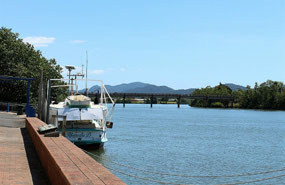
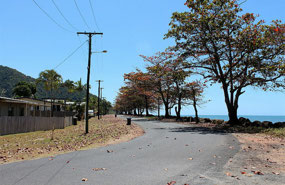
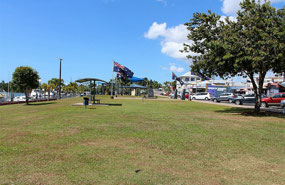
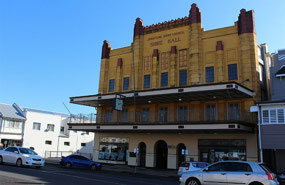
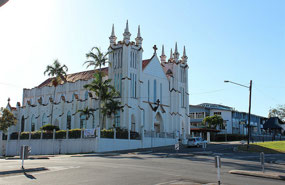
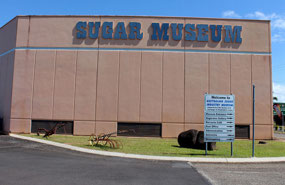
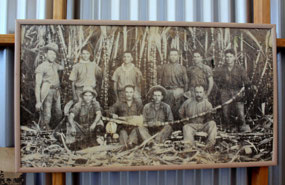
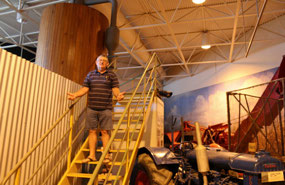

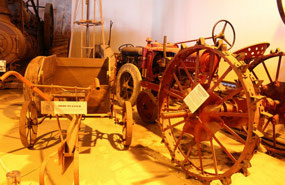
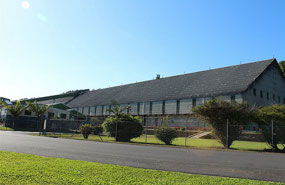
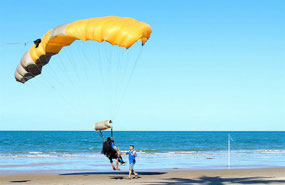
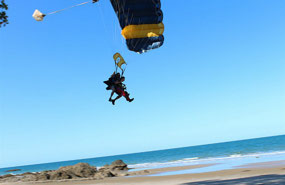
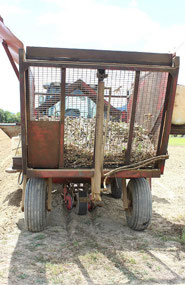
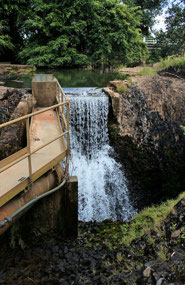

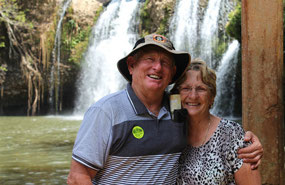
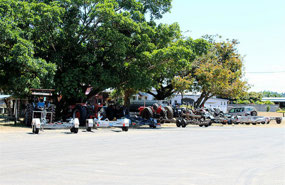

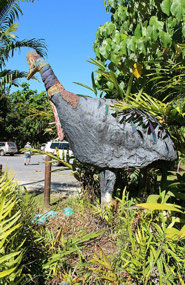
2025-05-22